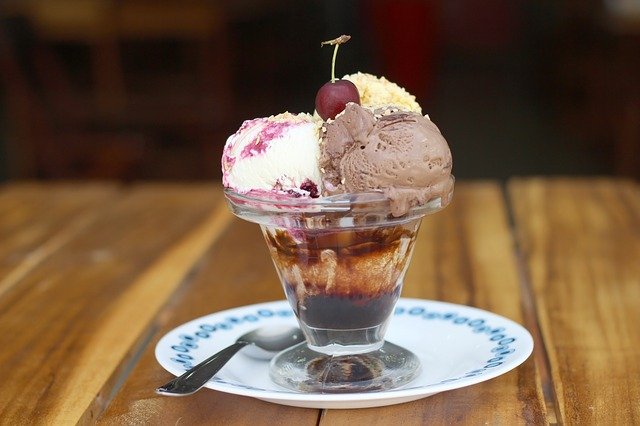By Tim Lambert
Dedicated to Jane Hummerstone
Early Desserts
In the Middle Ages, rich people ate desserts like preserved fruits, jelly, and wafers made from batter. Furthermore, the Italians have been eating panettone since at least the 15th century, but its origins are lost in legend.
The Romans knew that eggs could be used for binding. However, custard, as we know it, was invented in the Middle Ages.
However, in the Middle Ages, most puddings were meat-based. Rice pudding was known, but until the 19th century, it was regarded as a medicine. It was supposed to be good for digestive ailments.
The Tudors were also fond of desserts (if they could afford them). The rich ate preserved fruit, gingerbread, sugared almonds, and jelly. However, in the 16th century, sugar was very expensive, so most people used honey to sweeten their food.
Marzipan was eaten in England from the Middle Ages. Marzipan is a paste made of almonds and sugar. The Tudors used marzipan to make edible sculptures of animals, castles, trees, and people called subtleties.
At Christmas, the Tudors enjoyed mince pies, but they had far more significance than today in that they had 13 ingredients to represent Jesus and the apostles, they contained fruit (raisins, currants, prunes) and spices (cloves, mace, black pepper, saffron) and also mutton to represent the shepherds. The fashion was for them to be shaped like a crib, but this practice was banned by Oliver Cromwell.
The Tudors also had Christmas pudding, but this was shaped like a sausage and contained meat, oatmeal, and spices. Twelfth Night cake was a fruitcake baked with an item in it, like a coin or dried bean; whoever found it became King or Queen or host for the evening’s entertainment.
Another dessert, syllabub, was invented in the 16th century. Moreover, Banbury cakes were first mentioned in 1586. By the end of the 16th century, people in England were eating fruit fool. (Its name has nothing to do with idiots. It is derived from the French word fouler, meaning to mash.)
Blancmange was originally chicken stew flavored with almonds, but in the 17th century, it became a white dessert. Barley sugar also dates from the 17th century. Bread and butter pudding also became a common dish in the 17th century. Meanwhile, people in England first began eating yogurt in the 17th century.
In the 17th century, people in England began eating ice cream. In the 18th century, people began to eat trifles similar to the modern dessert. Furthermore, mousse was invented in the 18th century.
Modern Desserts
For centuries, most puddings were meat-based. In the 19th century, puddings took on their modern ‘sweet’ form. Furthermore in the 19th century, with the Industrial Revolution, the mass production of cakes and jelly began. In 1837, Alfred Bird invented custard powder. Furthermore, new desserts were invented in the 19th century.
Bakewell tart is known locally as Bakewell pudding. It was, supposedly, invented by accident in 1859. However, similar puddings were made in the area as early as the 16th century, and the ‘accident’ story is now seen as doubtful.
Roly Poly pudding was invented in the 19th century. Peach Melba was invented at the end of the 19th century. Meanwhile, Nancy Johnson invented a hand-operated ice cream maker in 1843.
In the late 19th century, cookery writer Agnes Marshall was known as the Queen of Ices. In 1888, she published Mrs A. B. Marshall’s Book of Cookery. In it, she described ice cream cones. She is widely regarded as the inventor of the ice cream cone.
Lastly, 25 August is National Banana Split Day

Last revised 2025